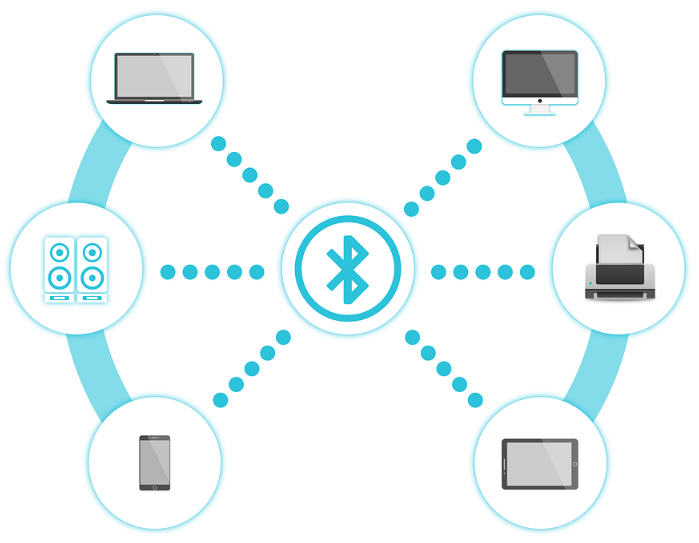Bluetooth 5.0, what’s new and different?

September 8, 2020
Bluetooth 5.0 is the latest specification of the Bluetooth communications standard. It is frequently used for wireless communication between devices, such as a wireless headset and a Smartphone, or without going any further, a PS4 or Xbox One with its corresponding controller.
What exactly is Bluetooth?
Bluetooth is a wireless communication protocol between devices. With it we can connect different devices with a secure radio frequency in the ISM band of 2.4 GHz, and through this connection you can transmit voice and data between them without having to physically connect them by cables.
A new version of the Bluetooth standard means several enhancements, but only when used with compatible peripherals. In other words, you won’t see any immediate benefit of upgrading to a Bluetooth 5.0 phone if all your Bluetooth accessories were designed for an earlier version of Bluetooth. However, Bluetooth is backward compatible, so you can continue to use your existing Bluetooth 4.2 and earlier devices with a Bluetooth 5.0 phone. And when you buy new Bluetooth 5.0-enabled peripherals, they’ll work better with your Bluetooth 5.0 phone.
What Bluetooth 5.0 is for?
Bluetooth 5.0 has certain features, it can, for example, transmit audio to two different speakers at once, ideal for mounting a good audio system at home. Although, of course, it is not the best option for indoors, but for outdoors.
Bluetooth 5.0 increases the signal distance four times, which is going to be ideal when using drones, as it won’t be necessary to be at such a close distance. This triggers the autonomy these devices can have at the distance level, of course.
With Bluetooth 5.0, devices can use data transfer speeds of up to 2 Mbps, which is twice what Bluetooth 4.2 supports. Devices can also communicate at distances of up to 800 feet (or 240 meters), which is four times the 200 feet (or 60 meters) allowed by Bluetooth 4.2. However, walls and other obstacles will weaken the signal, as they do with Wi-Fi.
Bluetooth 5.0 enables faster file transfer speed, you can set aside cables to transfer files to your computer. Best of all: you no longer have to lose quality when it comes to transmitting photos via WhatsApp, you can transfer the entire files without wasting time, which is what happens currently when you try to stream a file via Bluetooth.
Bluetooth Low Energy
Importantly, all the improvements being made to Bluetooth are to the low-energy Bluetooth specification, which was introduced again with Bluetooth 4.0, and not to the classic Bluetooth radio that uses more power. Bluetooth Low Energy is designed to reduce the power use of Bluetooth peripherals. It was originally used for portable devices, beacons and other low-power devices, but had some serious restrictions.
For example, wireless headphones could not communicate via Bluetooth low Energy, so they had to use the most energy-hungry classic bluetooth standard instead. With Bluetooth 5.0, all audio devices communicate via bluetooth low power, which means lower power consumption and longer battery life. Many more types of devices will be able to communicate via Bluetooth Low Energy in the future.
Bluetooth classes and versions
Bluetooth devices are classified into different classes depending on their transmission power, and their effective coverage. For classes, the limit is not set by the less powerful device, but by the most powerful. This means that if you have a Class 2 device, with only 20 meters range, if the other device is an average class of 100 meters range, both can communicate at more than 20 meters.
- Class 1: it has a range of up to 100 meters, with an average consumption power of 100 mW.
- Class 2: it has a range of up to 20 meters, with an average consumption power of 2.5 mW.
- Class 3: it has a range of up to 1 meter, with an average consumption power of 1 mW.
- Class 4: it has a range of up to 0.5 meters, with an average consumption power of 0.5 mW.
Just as classes mark the range of action of Bluetooth devices, the different versions that have been appearing over the years mark their characteristics and what they are able to do.
Bluetooth 1.0
It was the first version released in 1999, and precisely because it was the first step for technology, it had many connectivity and security issues. It is currently deprecated.
Bluetooth 1.1
It was the first update to Bluetooth 1.0, and arrived in 2002. It is already a mature and commercial version with a transmission rate of around 721 kbps.
Bluetooth 1.2
The second update to Bluetooth 1.0, which arrived in 2003 and reduced interference that still existed in version 1.1 to finish tuning the technology.
Bluetooth 2.0
The second major version of Bluetooth arrived in 2004, although compatible with 1.2. Its main feature was the introduction of enhanced data rate (EDR), which allowed it to offer a transmission rate of just over 2 Mb/s.
Bluetooth 2.1
The next version released in 2007, which maintained the same transmission rate as its predecessor. However, it introduced a feature that changed Bluetooth forever, the possibility that one terminal could add to another, and connect automatically without the need for a PIN or anything like that.
Bluetooth 3.0
This version arrived in 2009, and brought with it the term or surname HS of High Speed (high speed). It was a big improvement in the transmission rate, which could reach 24 Mbps.
Bluetooth 4.0
This is possibly one of the most important versions of the standard, as it began to combat the excessive battery consumption of the technology using Bluetooth Low Energy. The version arrived in 2010, maintained the transfer rate of 24 Mb/s and thanks to its low power consumption began to be used on smaller and less powerful devices.
Bluetooth 4.1
Arrived in 2013, and was characterized by focusing mostly on the world of IoT (Internet of Things) by allowing connection between small devices without intermediaries.
Bluetooth 4.2
This next update came in 2014, and implemented the IPv6 protocol to allow direct connection over the Internet.
Bluetooth 5.0
In mid-2016 came the big revolution, a new step forward that doubled the transfer rate, quadrupled range, continued with low IoT-thought consumption and allowed for more data in each message transferred. In terms of numbers, the transfer rate was up to 50 Mb/s, and the range up to 240 meters.
Bluetooth 5.1
The new version that arrived in 2019 revolved around location, allowing devices to know the location of other devices to which they are connected with a margin of centimeters. You can also identify the direction from which a signal you are looking for comes from.
Bluetooth LE Audio
It’s a new standard released in early 2020, and it improves sound quality and energy efficiency on all devices that connect for audio functions. It uses a new codec, the Low Complexity Communication Codec (LC3), which can more efficiently compress and decompress the data being transmitted, and allows audio transfer to multiple devices at once.








